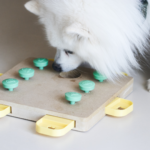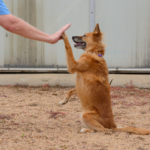Introduction
Throwing a dog-friendly party or event isn’t just a treat for your furry friends; it’s an opportunity to create lasting memories for both pets and their owners. In this guide, we’ll explore the essentials of hosting a canine carnival, offering insights and solutions for a successful and enjoyable experience for all.
Setting the Scene: Creating a Pawsitively Inviting Atmosphere
When it comes to hosting a canine carnival, setting the scene is paramount to ensure a pawsitively inviting atmosphere for dogs and their owners. However, this task comes with its own set of challenges, particularly in catering to the diverse sizes and temperaments of our four-legged guests. Here, we’ll explore potential issues and practical solutions to curate an environment where every dog feels safe, comfortable, and ready for a tail-wagging good time.
Potential Issues: Ensuring a Safe and Comfortable Environment
One of the primary concerns when hosting a dog-friendly event is providing a space that accommodates the varied needs of dogs, considering differences in size, energy levels, and social behaviors. Without careful planning, there’s a risk of creating an environment that might be overwhelming for some dogs or pose safety hazards.
Solutions: Tips on Securing the Venue, Designating Play Areas, and Providing Shaded Spots
Securing the venue is the foundational step in ensuring the safety of all attending dogs. Choose a location with secure fencing to prevent any accidental escapes and designate clearly marked play areas based on dog sizes and energy levels. This helps in creating zones where dogs can interact comfortably.
In addition to play areas, it’s crucial to offer shaded spots where dogs can retreat from the sun and rest. Dogs, much like their human counterparts, can easily get fatigued, especially in outdoor settings. Providing shaded areas with water stations ensures that every dog has a place to cool down and recharge.
Fetching Fun: Planning Entertaining Activities for Dogs
When hosting a dog-friendly event, keeping our canine companions entertained is key to a successful gathering. The potential issue of keeping dogs engaged and preventing boredom can be effectively addressed with a thoughtful approach to planning entertaining activities. Let’s explore some innovative solutions to ensure a tail-wagging good time for our furry friends.
Interactive Games: One surefire way to captivate canine attention is through interactive games. Consider setting up a doggy treasure hunt with hidden treats or toys scattered around the venue. This not only stimulates their senses but also taps into their natural instincts. Another engaging option is a dog-friendly version of musical chairs, where owners walk their dogs around a circle of mats, and when the music stops, they guide their furry companions to sit on a mat.
Agility Courses: For more active and agile dogs, an agility course provides both mental and physical stimulation. Include hurdles, tunnels, and weave poles to create a mini obstacle course. This not only challenges their coordination but also strengthens the bond between dogs and their owners as they navigate the course together. Ensure the course is suitable for dogs of all sizes and fitness levels, allowing each participant to enjoy the experience.
DIY Toys: Inexpensive and eco-friendly, do-it-yourself (DIY) toys can add a personalized touch to the event. Encourage attendees to bring their own DIY toys, such as braided rope toys or simple fetch items made from recycled materials. This not only provides entertainment but also sparks creativity among dog owners.
Pawesome Snacks: Catering to Canine Taste Buds
When organizing a dog-friendly event, addressing the dietary needs of our furry guests is crucial for their enjoyment and well-being. Potential issues such as dietary restrictions and the need for a variety of treats can be effortlessly tackled with thoughtful planning and consideration. Let’s explore some solutions to ensure that the snacks provided are nothing short of pawesome.
Homemade Dog Treats: One of the best ways to cater to canine taste buds while addressing dietary concerns is by offering homemade dog treats. Creating treats from simple, dog-friendly ingredients not only allows for customization but also ensures that dogs with specific dietary restrictions can indulge safely. Consider recipes using ingredients like peanut butter, sweet potato, or oats for a tasty and wholesome experience. This not only guarantees a diverse treat selection but also adds a personal touch to the event.
Pet-Friendly Catering Services: For those who prefer a hassle-free approach, exploring pet-friendly catering services is an excellent solution. Many catering companies specialize in creating menus tailored to canine preferences, offering an array of treats suitable for different dietary needs. From grain-free options to special treats for sensitive stomachs, these services can provide a convenient and tailored snacking experience for our furry friends.
Fresh Water Stations: Amid the excitement and play, it’s essential to ensure that dogs stay hydrated. Set up fresh water stations strategically throughout the venue, making it easily accessible for both dogs and their owners. Hydration is key to keeping dogs comfortable and happy during the event.
Social Paws: Encouraging Positive Interactions Among Dogs
Creating a harmonious and enjoyable social environment for dogs involves addressing potential issues related to conflicts and managing diverse personalities. Here are effective solutions to foster positive interactions and ensure a delightful experience for both the canine guests and their owners.
Strategies for Introducing Dogs: When bringing together dogs with varying temperaments, a careful introduction is key. Start by allowing dogs to greet each other in a neutral space, preferably on-leash, under the watchful eyes of their owners. Gradual and supervised introductions help prevent overwhelming encounters, allowing dogs to establish a rapport at their own pace.
Setting Ground Rules: Clearly defined ground rules contribute significantly to a positive social atmosphere. Communicate guidelines to owners, emphasizing the importance of monitoring their dogs’ behavior and intervening if necessary. Encourage responsible ownership by reminding attendees to respect each other’s boundaries and be mindful of their dogs’ reactions to different stimuli.
Designated Quiet Space: Recognizing that not every dog is equally social, having a designated quiet space is crucial. This area serves as a retreat for dogs needing a break from the excitement. It provides a refuge for more introverted or anxious dogs, allowing them to relax and recharge away from the crowd. Including comfortable bedding, water, and toys in this area ensures a comforting environment.
Safety Fur-st: Prioritizing the Well-Being of All Attendees
When hosting a dog-friendly event, ensuring the safety and well-being of all attendees is paramount. Addressing potential hazards and being prepared for emergencies are essential components of a successful gathering. Here are key solutions to prioritize the safety of both canine and human participants:
First Aid Tips: Equip yourself with basic first aid knowledge for dogs. Be prepared to address common injuries or issues that may arise during the event, such as cuts, scrapes, or overheating. Have a canine first aid kit on hand, including items like bandages, antiseptic wipes, and any necessary medications for specific dogs in attendance. Offering a designated first aid station ensures quick access to essential supplies.
Contact Information for Veterinary Services: In case of emergencies, having contact information for nearby veterinary services is crucial. Display this information prominently at the event venue and provide attendees with a list of local vet clinics and emergency hotlines. This proactive approach enables swift action if immediate medical attention is required.
Pet-Proofing the Event: Conduct a thorough assessment of the event space to identify and mitigate potential hazards. Remove or secure any toxic plants, chemicals, or items that could pose risks to dogs. Ensure that the venue is securely fenced to prevent dogs from wandering off. Implement measures to prevent tripping hazards, such as securing loose cables or wires.
Conclusion
In wrapping up our guide to hosting the ultimate canine carnival, we’ve explored the key elements that contribute to a tail-wagging success. Creating a dog-friendly atmosphere involves careful planning, from securing the venue to providing interactive activities and ensuring the safety and well-being of all attendees.
Remember, a successful dog-friendly party goes beyond just the enjoyment of our furry friends; it fosters a sense of community among pet owners, strengthens the bond between dogs and their humans, and creates lasting memories. As you embark on the journey of organizing your next event, keep in mind the importance of a positive and inclusive environment.








